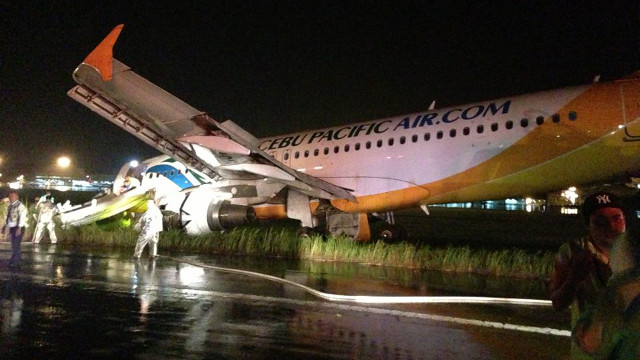SUMMARY
This is AI generated summarization, which may have errors. For context, always refer to the full article.

MANILA, Philippines (UPDATED) – The officers on board the Cebu Pacific aircraft that overshot the runway of the Davao International Airport on June 2 may have failed to follow standard operating procedures (SOP) in the aviation industry.
According to an aviation expert, the SOP for pilots of an aircraft in an emergency situation is to order the cabin crew to “immediately evacuate” passengers.
“An aircraft in an emergency situation is like a sinking ship. There is no toying around it because it may not be safe to stay inside the cabin,” said Benjamin Solis, a former Philippine Airlines pilot and strategy consultant for Clark airport.
“When an aircraft lands where it is not supposed to be, the pilot calls for an immediate evacuation and the cabin crew must immediately open the doors and put out the slides as quick as possible,” he said in an interview with Rappler on Monday, June 3.
He was responding to questions arising from the length of time — around 30 minutes — that it took the Cebu Pacific crew to let its 165 passengers disembark, prompting Ateneo de Davao University to issue a scathing letter to the Gokongwei-led airline.
No one was injured, but some passengers complained of the lengthy time it took them to be deplaned.
Most of the passengers also had to walk almost a kilometer just to reach the arrival section of the airport without any personnel from Cebu Pacific offering assistance or even comfort, one passenger commented.
The chief of the Civil Aeronautics Board (CAB), which is tasked to oversee the economic aspects of the ailrine industry, said the airline crew would be in the best position to assess whether the situation is an emergency or not.
“Under that situation, it’s the airline who could better assess the situation before deciding whether to evacuated the passenger or if their health is at risk,” CAB chief Carmelo Arcilla told Rappler in a phone interview.
He noted that under the Bill of Rights’ full disclosure section, airlines have to tell passengers what incident has occurred.
READ: 6 rights you have as an airline passenger
2.5-minute response time
Solis also raised questions on why it took the fire and rescue team of the Davao airport longer than 2.5 minutes to attend to the distressed aircraft.
“In search and rescue efforts in an airport, firetrucks must be able to reach any part of the airport under 2.5 minutes based on ICAO standard,” he added. Solis has helped design airports all over the world, including those in India, as well as set up pilot training schools.
ICAO, or the International Civil Aviation Organization, sets the safety standards for airlines, airports, and other players in the aviation industry.
The Cebu Pacific incident occurred during bad weather in Davao. “That’s regardless of weather,” Solis added.
“That’s a studied thing – if you go beyond 2.5 minutes, someone can die,” he said.
Pilot error?
On mid-day Monday, June 3, investigators of the Civil Aviation Authority of the Philippines (CAAP), the local aviation body tasked to investigate aviation incidents, arrived in Davao via General Santos, an airport about two hours away.
CAAP is now investigating whether the plane itself malfunctioned, or whether there was a lapse on the part of the pilot.
CAAP Deputy Director General Captain John Andrews told reporters the public should not be quick to conclude that pilot error played a role in the faulty landing.
Landing in a bad weather and with the presence of crosswinds is a major challenge even to the best and most experienced pilots, Andrews said.
As soon as the plane’s wheels hit the runway, however, Andrews said the pilot should be able to steer the plane toward the right direction since it is no longer affected by the crosswinds. Overshooting occurs when the pilot is unable to direct the plane properly.
The Cebu Pacific aircraft was being flown by Captain Antonio Roel Oropesa, who has 1,600 flight hours, and his first officer, Edwin Perello, who has 700 flight hours.
Davao airport is the 3rd busiest airport in the country. About 40 flights had to be re-routed and hundreds of passengers were affected.
Transportation Secretary Joseph Emilio Abaya ordered the immediate resumption of operations at the airport.
Abaya said it takes about 2 to 3 hours to remove the plane from the runway, which is about 3,000 meters long. – with reports from Aya Lowe/Rappler.com
Add a comment
How does this make you feel?
There are no comments yet. Add your comment to start the conversation.